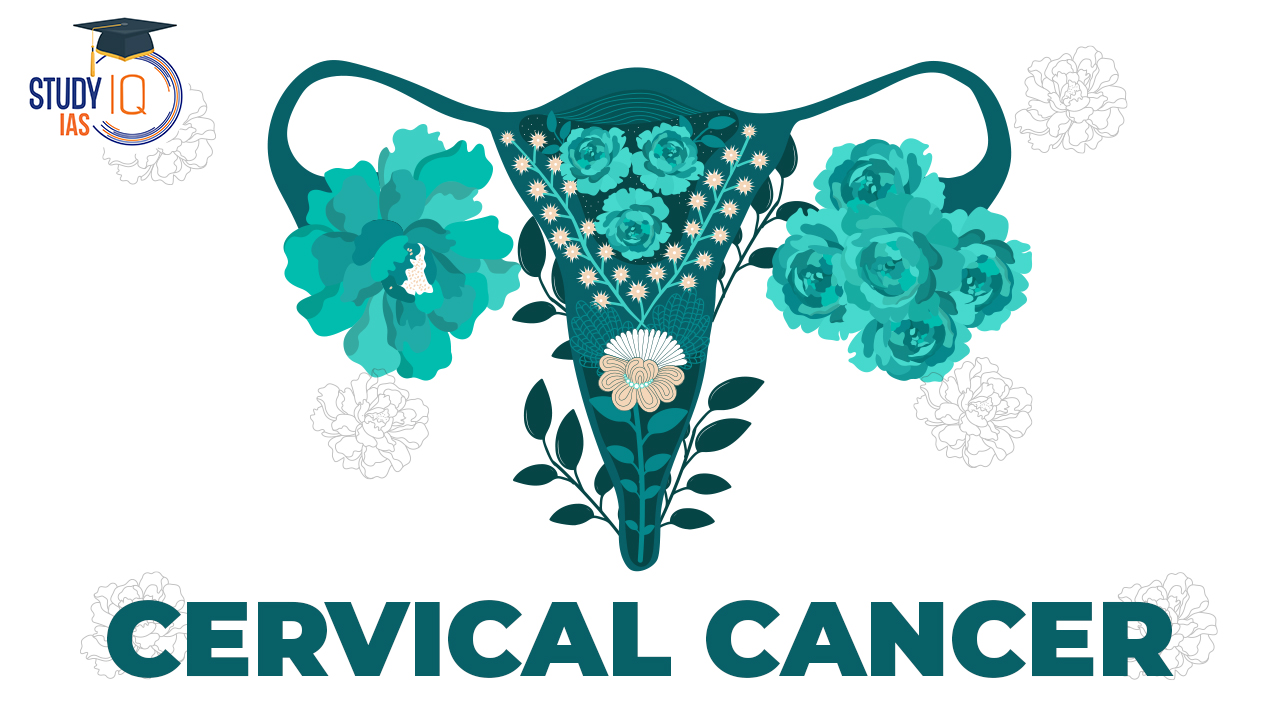Table of Contents
Context: The interim Union Budget emphasises the vaccination of girls aged 9-14 against cervical cancer, showcasing India’s efforts in promoting women’s health.
Cervical cancer is a significant global health issue, affecting women of all ages. It is essential to be aware of its types, symptoms, causes, prevention, and treatment options. Cervical cancer is primarily associated with human papillomavirus (HPV) infection, but there are different types of cervical cancer, each with its unique characteristics and challenges. In this article, we will delve into the various aspects of cervical cancer to increase awareness and promote early detection and prevention.
Cervical Cancer: HPV Vaccination for Girls Aged 9-14
During her budget speech, Finance Minister Nirmala Sitharaman announced the government’s promotion of HPV vaccination for girls aged 9-14 as a preventive measure against cervical cancer. Cervical cancer ranks second among women’s cancers in India, with over 123,000 new cases and 77,000 deaths reported in 2020.
Despite the commitment, specific details about the inclusion in the national immunization program were not provided, creating uncertainties. The NTAGI recommended the HPV vaccine’s introduction into the UIP in 2022, proposing a catch-up program for girls aged 9-14, followed by routine introduction at nine years of age. Several states have already taken proactive steps in this direction.
| Cervical Cancer Challenge in India |
|
What is Cervical Cancer?
Cervical cancer originates in the cervix, the lower part of the uterus. Most cases are linked to sexually transmitted Human papillomavirus (HPV) strains. While the body’s immune system often fends off HPV, in some cases, the virus persists for years, triggering the transformation of cervical cells into cancerous ones.
Types of Cervical Cancer
Cervical cancer is primarily classified into two main types:
- Squamous Cell Carcinoma: This is the most common type, accounting for approximately 70% to 90% of cervical cancer cases. It begins in the thin, flat cells lining the cervix’s surface.
- Adenocarcinoma: This type comprises a smaller percentage of cervical cancer cases and originates in the glandular cells of the cervix.
It’s important to note that some cervical cancers can have mixed features, showing characteristics of both squamous cell carcinoma and adenocarcinoma.
Cervical Cancer Symptoms
Cervical cancer often develops silently in its early stages, which underscores the importance of regular screenings. However, as the disease progresses, it can manifest with the following symptoms:
- Abnormal Vaginal Bleeding: This can include bleeding between menstrual periods, after menopause, or after sexual intercourse.
- Pelvic Pain or Discomfort: Women with cervical cancer may experience persistent pain or discomfort in the pelvic area.
- Pain During Sexual Intercourse: Pain or discomfort during sexual activity can be a symptom of cervical cancer.
- Unexplained Weight Loss: Sudden and unexplained weight loss, along with fatigue, can sometimes be associated with advanced cervical cancer.
Cervical Cancer Causes
The primary cause of cervical cancer is the human papillomavirus (HPV), a group of sexually transmitted viruses. Specific high-risk strains of HPV can lead to changes in cervical cells, ultimately resulting in cancer. Other factors that can increase the risk of developing cervical cancer include:
- Smoking: Women who smoke are at a higher risk of cervical cancer. Smoking may weaken the immune system’s ability to combat HPV infections.
- Weakened Immune System: Conditions or medications that suppress the immune system can increase susceptibility to HPV infection and the development of cervical cancer.
- Family History: A family history of cervical cancer can slightly elevate the risk, suggesting that genetic factors may play a role in some cases.
Signs of Cervical Cancer
Cervical cancer often progresses silently in its early stages, but as the disease advances, it may manifest with a range of symptoms. Notable signs include abnormal vaginal bleeding, which can encompass bleeding between menstrual periods, after menopause, or post-sexual intercourse. Women with cervical cancer may also experience pelvic pain or discomfort and pain during sexual activity. Unexplained weight loss and fatigue are sometimes linked to advanced cervical cancer.
Additionally, changes in vaginal discharge, leg swelling, and other symptoms may occur. If any of these signs are present, seeking prompt medical attention is crucial for diagnosis and treatment. Regular screenings, like Pap tests and HPV tests, are also vital for early detection.
Cervical Cancer Vaccine
The cervical cancer vaccine, also known as the HPV vaccine, is a powerful preventive measure against cervical cancer. It targets specific strains of the Human Papillomavirus (HPV) that are strongly associated with this cancer. The vaccine is highly effective and is recommended for adolescents, protecting against HPV types 16 and 18, which are the main culprits behind cervical cancer, as well as other strains responsible for genital warts and additional HPV-related cancers. This vaccination is a vital component in the fight against cervical cancer.
What is HPV
Human papillomavirus (HPV) is the most common sexually transmitted infection (STI). HPV is caused by sexual activity and age. About 75% of all sexually active adults are vulnerable to at least one HPV type. Adolescent girls and women are more vulnerable to cancer caused by HPV infection.
HPV Vaccine for Cervical Cancer
The HPV Vaccine is a critical tool in the fight against cervical cancer. It is designed to prevent infection with certain high-risk strains of the Human Papillomavirus (HPV) that are known to be the primary cause of cervical cancer. The vaccine is highly effective in reducing the risk of cervical cancer and is an essential part of preventive healthcare for individuals, particularly adolescents.
Three main types of HPV vaccines are available:
- Quadrivalent Vaccine (Gardasil): This vaccine guards against four types of HPV, including HPV 16 and 18, which are responsible for the majority of cervical cancer cases, and HPV 6 and 11, which cause genital warts.
- Bivalent Vaccine (Cervarix): Cervarix provides protection against the high-risk HPV strains 16 and 18, which are the most common culprits behind cervical cancer.
- Nonavalent Vaccine (Gardasil 9): Gardasil 9 is the most comprehensive of the three, offering protection against nine different HPV strains, including those responsible for most cases of cervical cancer.
Need for the HPV Vaccine
- According to a study, India accounts for the highest number of cervical cancer cases in Asia, followed by China.
- More than 58% of all cervical cancer cases and deaths globally were estimated in Asia with India accounting for 21% of cases and 23% of deaths, followed by China (18% and 17%).
- In India, the incidence rate of cervical cancer is 18 per 1,00,000 women, and based on WHO estimates in 2019, over 45,000 women died of the disease.
- The WHO has specified that countries must reach and maintain an incidence rate of less than 4 new cases per 1,00,000 women a year by 2030.
- To achieve this goal, one of the most important initiatives is that 90% of girls will have to be vaccinated with the HPV vaccine by the age of 15.
What is CERVAVAC?
CERVAVAC, India’s first indigenous quadrivalent human papillomavirus (qHPV) vaccine, is designed to combat four HPV strains: Type 6, Type 11, Type 16, and Type 18. Quadrivalent vaccines stimulate an immune response against four different antigens, like various viruses or microorganisms. CERVAVAC employs Virus-Like Particles (VLP), akin to Hepatitis B vaccines.
It has obtained approval from India’s Drugs Controller General and received clearance from the government advisory panel NTAGI for public health use. This vaccine holds significant potential to combat cervical cancer and could be a cost-effective addition to national HPV vaccination programs. It’s most effective when administered before initial sexual activity.
Global HPV Vaccination Goals and Progress
WHO’s ’90-70-90′ Targets: By 2030, the aims are to have 90% of girls vaccinated by age 15, 70% of women screened by ages 35 and 45, and 90% of affected women treated.
International Success Stories
- Over 100 countries have seen a decrease in cervical cancer incidences due to HPV vaccination programs.
- Scotland reports no cervical cancer cases in fully vaccinated women born between 1988-1996.
- Australia aims to eliminate cervical cancer by 2035, with vaccination programs for both girls and boys.
- Rwanda’s successful vaccination drive has led to a drop in HPV types among women.
Regional HPV Vaccination Efforts
Southeast Asia’s Progress
- Six out of 11 countries, including Bhutan, Indonesia, the Maldives, Myanmar, Sri Lanka, and Thailand, have nationwide HPV vaccination programs.
- Bhutan reached 95% coverage for targeted girls and started vaccinating boys in 2021.
India’s Localised HPV Vaccination Model
- The Sikkim Model: Sikkim achieved 97% HPV vaccination coverage in 2018 through effective communication strategies.
- India’s Indigenous Vaccine Development: India developed Cervavac, an affordable quadrivalent HPV vaccine, priced at ₹2,000 per dose.
Potential for Expanding HPV Vaccination
- Inclusion of Boys in Vaccination Programs: Expanding vaccination to adolescent boys could enhance the prevention of HPV transmission.
- Single-dose HPV vaccination has been recognized to offer similar protection as multiple doses.
- India’s Track Record and Vaccination Infrastructure: India’s success with COVID-19 vaccination campaigns instils confidence in the scalability of HPV vaccination efforts.
Societal and Economic Benefits of HPV Vaccination
- Preventing HPV infections can reduce the societal and economic burden of cervical cancer.
- Vaccination helps prevent premature deaths, positively affecting the health and education of children from affected families.
Addressing the Cervical Cancer Challenges
- Overcoming Vaccine Hesitancy: Engaging communities and dispelling misinformation is crucial to counter vaccine hesitancy.
- U-WIN Initiative: Similar to Co-WIN, U-WIN is a digital platform for tracking all immunizations across India.
- Improving Access and Awareness: Access to vaccination services, especially in underserved populations, is vital.
- Raising awareness and cultural sensitivities is important for increasing vaccine acceptance.
- Strategies for Demand Improvement: Education through schools and the use of social media can help generate vaccine demand.
- Collaborative Efforts: Partnerships between governments, communities, healthcare providers, and organisations are key to vaccination program success.
Cervical Cancer Treatment
Cervical cancer treatment is determined by the cancer’s stage, the patient’s overall health, and other individual factors. The main treatment modalities for cervical cancer include:
- Surgery: Depending on the stage of cancer, surgical options may include removing the abnormal cervical tissue, a hysterectomy (removal of the uterus), or more extensive procedures if the cancer has spread to surrounding tissues.
- Radiation Therapy: High-energy X-rays are used to target and kill cancer cells. Radiation therapy may be external (from a machine outside the body) or internal (brachytherapy, where radioactive materials are placed inside or near the tumor).
- Chemotherapy: Medications are administered either intravenously or orally to kill or slow the growth of cancer cells. Chemotherapy can be used in combination with radiation therapy or surgery.
- Targeted Therapy: Some advanced cervical cancers may be treated with targeted drugs that specifically target cancer cells or the blood vessels that supply them.
- Immunotherapy: This emerging treatment approach helps the immune system recognize and attack cancer cells. It is still being studied for cervical cancer.
- Palliative Care: In advanced stages or when the cancer has spread, palliative care can help manage symptoms and improve the patient’s quality of life.
Cervical Cancer Awareness
Cervical cancer awareness is crucial for promoting early detection, and prevention, and ultimately reducing the impact of this disease. Here’s why cervical cancer awareness matters:
- Early Detection Saves Lives: Cervical cancer is highly treatable when caught in its early stages. Regular screenings, such as Pap tests and HPV tests, can detect precancerous changes and cervical cancer, enabling timely intervention.
- Preventable with Vaccination: HPV vaccination is a powerful tool in preventing cervical cancer. Raising awareness about the importance of vaccination for adolescents is vital.
- Knowledge Empowers Women: Informed women are more likely to take steps to protect their health. Educating women about the risk factors, symptoms, and prevention methods empowers them to make informed decisions.
- Reducing Stigma: Open discussions about cervical cancer reduce stigma, making it easier for women to seek screening and treatment without fear or embarrassment.
- Access to Healthcare: Awareness can help underserved communities gain access to healthcare services, including screenings and vaccination.
- Global Impact: Cervical cancer is a global issue. Raising awareness can lead to international efforts to address this preventable and treatable disease.
Cervical Cancer Awareness Month 2023
Cervical Cancer Awareness Month falls in January, presenting an ideal occasion for WHO and its partners to spotlight cervical cancer and HPV vaccination. This year, our focus revolves around a bold goal: eradicating cervical cancer within a few generations, which serves as the central theme for this awareness month.
Cervical Screening Awareness Week
Scheduled for June 19th to June 24th, 2023, Cervical Screening Awareness Week is an annual initiative. Its primary objective is to emphasize the significance of regular cervical screenings in promoting women’s health.
Cervical Cancer Elimination Day
17 November marks the Cervical Cancer Elimination Day of Action and the anniversary of the launch of the World Health Organization’s (WHO) Global strategy to accelerate the elimination of cervical cancer as a public health problem.
Cervical Cancer in India
Cervical cancer is a disease that occurs in a woman’s cervix and ranks as the fourth most prevalent cancer globally, but in India, it is the second most common cancer among women. India carries the heaviest burden of cervical cancer, contributing to nearly one in every four cervical cancer-related deaths worldwide, as indicated in The Lancet study.
Nearly all cervical cancer cases (99%) are associated with high-risk HPV infection, a widely prevalent virus primarily transmitted through sexual contact. The good news is that highly effective primary prevention methods, such as HPV vaccination, and secondary prevention measures, like screening and treating precancerous lesions, have the potential to avert the majority of cervical cancer cases.
Early diagnosis plays a pivotal role in the successful treatment of cervical cancer. When detected promptly and managed effectively, it is one of the most treatable forms of cancer. Therefore, raising awareness about prevention and early detection is of paramount importance in combating this disease.
Cervical Cancer UPSC
Cervical cancer, primarily linked to HPV infection, encompasses two main types: squamous cell carcinoma and adenocarcinoma. It often develops silently, with symptoms like abnormal vaginal bleeding, pelvic pain, and weight loss emerging as it progresses. HPV vaccines, including India’s CERVAVAC, provide powerful prevention. Treatment, contingent on the cancer stage, involves surgery, radiation, chemotherapy, targeted therapy, immunotherapy, and palliative care. Raising awareness during events like Cervical Cancer Awareness Month, Cervical Screening Awareness Week, and Cervical Cancer Elimination Day is critical in reducing the disease’s global impact.


 Agricultural Monitoring and Event Detect...
Agricultural Monitoring and Event Detect...
 Genetically Modified Crops in India, Reg...
Genetically Modified Crops in India, Reg...
 What are Polycyclic Aromatic Hydrocarbon...
What are Polycyclic Aromatic Hydrocarbon...





















